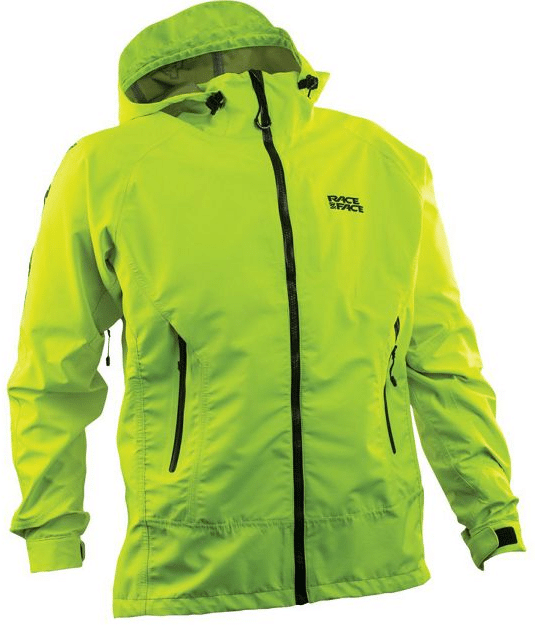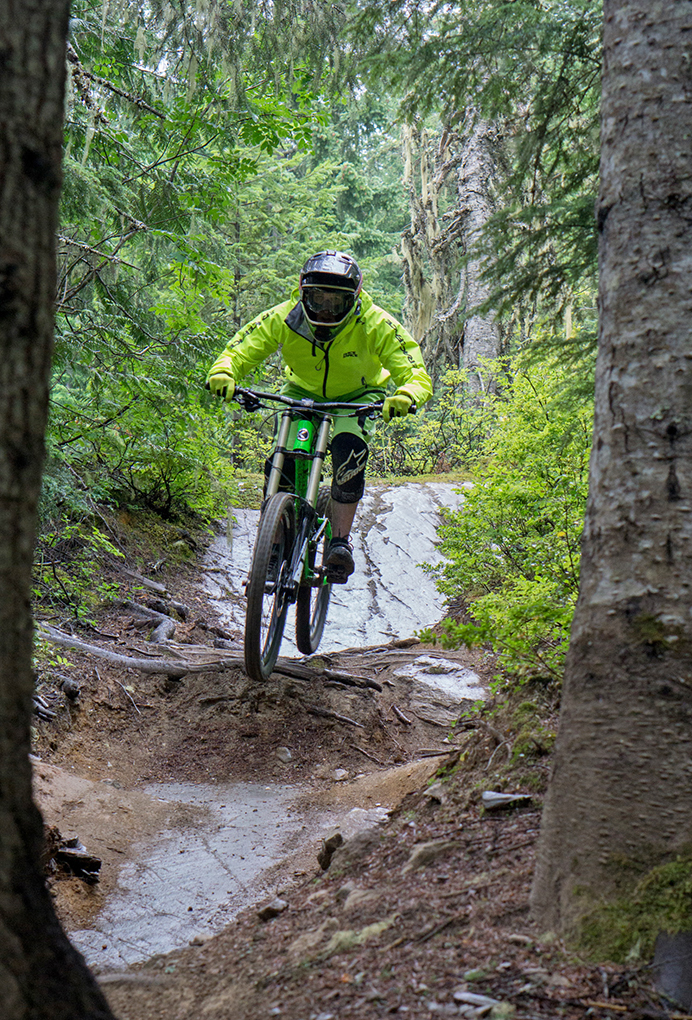
Race Face Team Chute Jacket
Size Tested: Medium
Features:
- 3-layer Waterproof/breathable membrane (mesh backing)
- Fully taped seams
- 3-point adjustable hood
- Cinch cord at hem
- Velcro cuff closure at the wrists.
- 2 hand warmer pockets.
- Internal media pocket
Color: Safety Yellow
MSRP: $190
Reviewer: 5’9″, 150 lbs.
Days Tested: 7
Test Locations: Whistler, BC
In the past, almost all the jackets I’ve used for riding haven’t breathed all that well and haven’t kept kept me dry when things really got wet, but this was largely my own fault. I’ve never wanted to spend much money on a nice, waterproof jacket to ride in because muddy rides (apart from getting any jacket very, very dirty) tend to involve me hitting the ground from time to time, which tends to rip up my jackets. I have nice waterproof/breathable shells that I ski in, but I don’t ride bikes in them because they’d get trashed.
Race Face hails from Vancouver, a place that has a lot of awesome riding as well as a lot of wet weather. They’ve managed to produce a quality jacket that holds up well to the elements as well as to the rigors of riding in sloppy, muddy conditions. And at the same time, their Team Chute jacket won’t set you back near as much as a high-end technical shell made for skiing, snowboarding, or mountaineering.
Fit
The Team Chute fits true to size. I wear a Medium in pretty much every piece of clothing I own, and my Medium Team Chute fit me pretty well. The cut of the jacket works well for riding; it’s a bit long in the tail (reaching down well below the hemline of my shorts), and the sleeves don’t ride up in any riding position.
Packability & Durability
The Team Chute is made with a material that feels heavier than a basic, minimalist rain jacket (like my $100 North Face Indylite), while not being so heavy that it feels cumbersome to ride in. While I was able cram it into my pack while out on a ride, it’s not I what I would call highly packable (if that’s what you’re looking for, check out the Race Face Nano Pullover).
But what the Team Chute lacks in packability, it makes up for in burliness. While riding in the Team Chute, I stuck my shoulder into a few trees and crashed through a few branches, none of which fazed the jacket in the slightest. I’ve had similar encounters rip through the material of thinner jackets, like a $75 REI shell that I used for a time until it got shredded in Fernie.
The Team Chute’s durability seems to be due, in part, to some additional paneling on the forearms – a place that’s likely to take a beating if you end up laid out on the trail.
Pockets, Pit Zips, Etc.
The Team Chute has two front-zippered, fleece-lined “hand warmer” pockets. I tend to ride with a ton of crap in my pockets (phone, keys, sunglasses, some tools, a bit of food, etc.), and these pockets were big enough to hold my normal array of junk. And while fairly roomy, the pockets are still slim enough to keep that junk from banging around excessively while riding.

The jacket also has an internal zippered “media” pocket. Like all the cool kids, my preferred media is vinyl, and I found this pocket to be quite a bit too small for that. It did, however, fit an iPod nicely, and it has a headphone port. There are also a few other non-zippered mesh pockets on the inside of the jacket that fit a pump and a tube nicely.
As for venting (aside from the main zipper), there are two long armpit zips that run from near the elbow well down the side of the torso. When fully opened, they dump heat quite effectively.
Other notable features include some standard Velcro closures at the wrists on the Team Chute, and a nice high collar with soft material on the parts that hit your face when the jacket is fully zipped. The waist of the jacket has a pull cord to tighten things down, but as I noted above, the waist was already snug enough that I didn’t find myself needing to use it.
Waterproofing
The Team Chute’s 3 layer shell material has a waterproof rating of 10,000mm and a breathability rating of 10,000g/m2. If you’re interested in an in-depth explanation of waterproof ratings and what those numbers relate to, give Sam Shaheen’s Outerwear 101 a read. In short, a jacket with a 10k/10k rating isn’t the most breathable, nor will it provide the highest possible level of waterproofing (some high-end 3 layer shells have ratings of 20k/25k or higher, but these usually cost $600+).
But for most outdoor pursuits, that’s perfectly fine. Any laminate with a waterproof rating of about 10,000mm ought to keep you very dry in all but the most torrential downpours. Consistent with this, I never had trouble staying dry in the Team Chute, and we rode in wet conditions in Whistler quite often.
On one particularly wet day, literally every piece of clothing I wore was sopping wet, but my shirt under the Team Chute jacket was completely dry. I had sat on the Garbonzo lift in a torrential downpour, then rode all the way back to the Whistler Village in the same downpour, then hosed off my bike—and myself—at the bike wash station. Yep, I pointed a pressurized hose directly at my chest, and none of that water made it through the Team Chute to my shirt.
The Team Chute jacket has fully taped seams, and hand warmer pockets’ zippers and pit zippers are waterproof. I haven’t noticed any signs of leakage at any of those points on the jacket. (My phone was in one of the jacket’s front pockets during my pressure-hose test, and it stayed completely dry as well.) The main zipper isn’t waterproof, but it is covered by a storm flap, and again, it kept water out.
Another nice design feature is the Team Chute’s mesh lining, a layer on the inside of the jacket that helps prevent that clammy, “stuck to your skin” feeling that some thin waterproof fabrics can cause.
